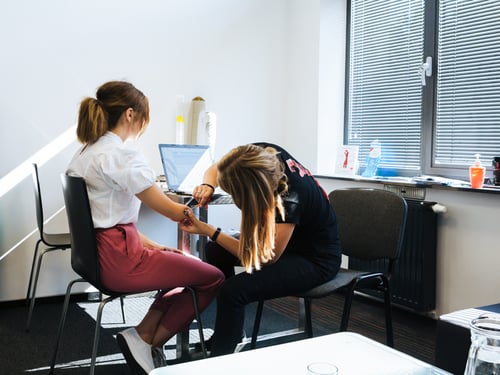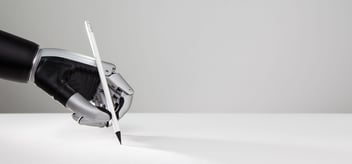The Upper Extremity Evaluation and Prosthesis Selection Process
For individuals considering choosing a prosthetic arm as a solution for upper-limb loss, it can be challenging to know where to begin. There are plenty of prosthetic options available on the market, but finding the right prosthesis is crucial.
Even before choosing a prosthetic, individuals need to determine which options are viable for them as each prosthetic candidate is unique. This is why the prosthetic process can sometimes be a long one. Fortunately, we’ve outlined the prosthetic process from start to finish in an effort to help individuals survey their options and know what to expect in this journey.
Meeting with the Prosthetic Center
The first step of the prosthesis process is to meet with your care team at the prosthetic center. For every prospective prosthetic user, a care team is formed. This team will work together with the patient to develop a comprehensive plan. First and foremost, the care team will develop an understanding of the patient’s medical history and current limb status as this could deem some options unviable.
Following this, the care team will communicate with the patient to create a list of goals and functional processes to determine viable prosthetic options. These goals should include functionality, appearance, and fit. With this information determined, the team will discuss the most appropriate devices to achieve the patient’s functional goals, in addition to suiting their personal preferences, body, and lifestyle.
A patient may come into the prosthetic center with a specific prosthesis in mind but without a clear understanding of how that devices works, especially regarding the patient’s daily routine. During this stage, it’s important that the patient clarify any functions and features that are important to them in a prosthesis.
For example, suppose a patient has an active and independent lifestyle. In that case, they may seek a more highly functioning prosthetic arm than a patient simply looking for a device with the right aesthetic. Certain prosthetic arms offer more advanced functions than others, so it is important to consider factors such as dexterity, strength, and customization capabilities.
Comprehensive Health Assessment
Following the initial meeting, the care team will perform a comprehensive health assessment on the patient. To start, the care team will complete a thorough review of the patient’s past medical history, including pre-amputation and post-amputation medical and psychological status. This is vital as it will help the care team better predict and manage the patient’s rehabilitation outcome in the future.
Once medical history is reviewed, the care team will then move on to the patient’s current condition, where they will assess the patient’s condition, primarily focusing on the residual limb and muscle function. That being said, there are additional factors that must be considered during the assessment, including:
- Overall health status
- Level of hand function
- Controllable health risk factors
- Pain assessment
- Behavioral and cognitive health
- Personal, social, and cultural contexts
The health assessment portion of the prosthetic process needs to be thorough to ensure that the prosthesis a patient chooses is not only well suited to their preferences but also their body. We at Zeus believe that a user’s prosthesis should serve as an extension of their body, will the same function and dexterity as they once had. As such, a patient’s health assessment is a crucial aspect of choosing the right prosthetic arm.
Once the assessment is complete, the care team and patient should have a thorough understanding of viable prosthetic options and expected rehabilitation time, leading us to the next step.
Decision Making
Finally, it is time for the patient and care team to work together to make a final decision. This must be a shared decision-making process, combining patient preferences with feasible prosthetic options. Specific options such as a body-powered prosthetic may not be viable for a patient with a limited range of motion, whereas a bionic hand would be a better option. As the patient may not have a clear understanding of options available on the market, this is where the care team comes in.
Once a decision is made, the patient and care team will create a rehabilitation and training plan. Forpatients opting to go with a more advanced prosthetic such as a bionic hand, a learning curve is to be expected. Patients need to be fitted to the arm and usually receive training on how to use it efficiently. As such, the care team and patient will discuss an expected timeline for fitting and training, ensuring that the patient is aware of the adjustment period to come.

A discharge plan is also essential to ensure that the patient will be ready to go home with their new prosthetic. Patients should have a support system ready, in addition to all of the equipment or home adjustments necessary to function independently. Care teams should also provide their patients with information regarding repairs or dissatisfaction with their prosthesis to ensure that they address any problems.
What Comes Next?
Once a patient and their care team have come to an agreement on the right prosthesis, the next stage is to be fitted. While that may seem like a fairly straightforward process, the fitting stage can be time-consuming - but for a good reason. Taking time to carefully fit the prosthetic arm to the patient is crucial as to not only minimize discomfort but also prepare the patient to learn how to most efficiently use their new device.
Should the patient choose a high-functioning bionic arm, the fitting process will be even more thorough. For devices such as ours, the Zeus, patients will utilize our software to adjust grips and positions in each individual finger. With this capability, patients can cater their hand to their unique tasks and activities, ensuring that it is compatible with their life and needs. As a result, this requires extra time and attention from both patients and our experts.
While extra time to learn and familiarize oneself with the device may seem inconvenient, it ultimately provides users with more dexterity and function, allowing them to get back to the activities they love. That being said, it’s important to understand the training and rehabilitation process fully, which is why we’ll discuss it more thoroughly in our next blog.










